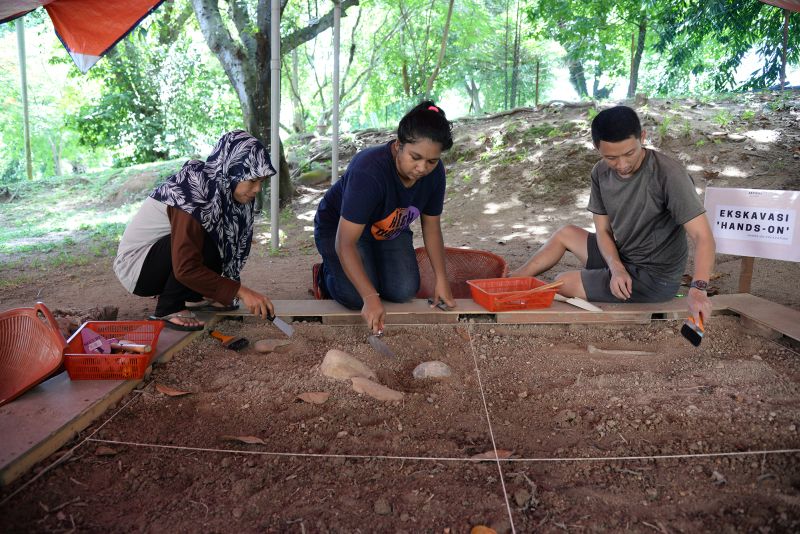GEORGE TOWN, June 10 ― Archaeology fans can get their hands dirty and dig up ancient artefacts at actual excavation sites in Perak and Kedah or at a mock excavation site at Universiti Sains Malaysia (USM).
USM recently launched its archaeotourism package, especially aimed at students and visitors interested in archaeology, for a hands-on tour of actual archaeological sites in Sungai Batu and Lenggong Valley. There is also an USM Archaeology Gallery within the USM compound in Penang that details all of the archaeological sites in Malaysia, with exhibits of artefacts dug up in those excavations.

The archaeotourism packages, managed by the Centre for Global Archaeological Research (CGAR), covers three different galleries in the northern region of Malaysia and is open to visitors from all over.
“We are the only university in this region with three archaeology galleries for visitors to explore, experience and find out about the cultures of ancient civilisations here,” said CGAR director Datuk Mokhtar Saidin.
“The whole country's prehistory records and information on archaeological excavations can now be found in USM, so visitors can find out details about the Perak Man or other prehistoric findings in Malaysia within the USM gallery,” he added.

USM Archaeology Gallery
There are three components in the gallery: the main gallery, an Orang Asli gallery and an archaeobiology gallery, all within one interconnected compound.
The main gallery is filled with a detailed history of excavations and discoveries in Malaysia along with a chronology of prehistoric finds in Malaysia that date back to 1.83 million years up to 1,000 years ago.
“We have a main gallery hall with a focus on one site and it will change periodically so when we have completed Guar Kepah, we will feature it in the main hall here,” Mokhtar said.

There are several rooms filled with posters of excavation sites, including neolithic and palaeolithic sites, and also a replica of the Perak Man in a display case. There are sections featuring the Malaysian prehistory, palaeolithic period, neolithic period, metal period and the early civilisation period.
Outside the gallery is the interactive site where there are eight activities for visitors, the first of which is a hands-on excavation site where you are taught how to slowly dig and sift out the sand to uncover an artefact from the ground.
The next station is a stone tool making experiment, where you get to try first hand how to make stone tools using just your bare hands and stones. From there, you can then use the stone tool you made to cut meat just like what prehistoric humans have been using before they discovered metal.
Next, there is a station showcasing the iron smelting process that was used in Kedah Tua, where a crude clay-like furnace is used to smelt iron ores.
“We have a brick making station for visitors to try making their own bricks the same way it was made during the Kedah Tua era,” Mokthar said.

From there, visitors can try making a replica or learn how to analyse artefacts at another station. As the path leads towards the Orang Asli gallery, there is a space for visitors to test out blow piping.
The Orang Asli gallery is a special exhibit on ethnography and research on the Orang Asli of Malaysia. A collection of their handicrafts, jewellers, weapons and hunting tools, some of which are very similar to items found in early civilisations, are also displayed.
Finally, the third gallery which is in another building, is an exhibition of skulls, skeletons and animal remains from archaeological research conducted by CGAR from 1987 until today.
A replica of the Perak Man is placed here and there is a display of skull replicas of different prehistoric findings from all over the world.

Sungai Batu Complex and Lenggong Valley
The Sungai Batu site, also known as the Kedah Tua civilisation site, was recognised as the earliest civilisation in Southeast Asia as it dates back over 2,500 years ago. The complex has over 97 excavation sites and counting.
There are four main site: the ritual site, ancient jetty, administrative buildings and iron smelting sites, within the complex to visit.

Visitors can book a guided tour along with its interactive package so everyone can experience what it is like to be an archaeologist for a day. They will be able to try their hands at the actual excavation sites, try out the iron smelting experiments and also try out brick making.
Sungai Batu is located in Kedah, very near Lembah Bujang, so visitors will need to drive there on their own as USM does not provide transportation to the site.
Over at the Unesco world heritage site of Lenggong Valley, USM is also offering a guided tour of the site and visitors will also need to drive there on their own.

Lenggong Valley is about 80km from Ipoh, Perak and it is the home of many prehistoric findings, particularly the Perak Man, which was uncovered in Gua Gunung Runtuh back in 1991.
“We can organise three days-two nights packages so that visitors can get to explore all of the sites within the Lenggong Valley and even before we launch these archaeotourism packages, we already have tourists coming to visit the sites and asking for guided tours,” Mokhtar said.
Lenggong Valley also offers similar interactive experiences of hands-on excavations, stone-tools making and snail finding activities.

The guided tour packages starts from RM5 (for students and senior citizens) while the full packages that include guided tours and interactive activities start from RM20 (for students).
Archaeotourism Unit,
Centre for Global Archaeological Research, USM
Tel: 04-6535970 (Hamizah), 04-6532683 (Syahir)
Email: [email protected]




















